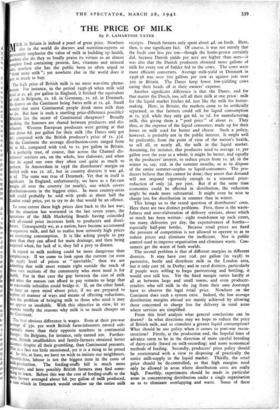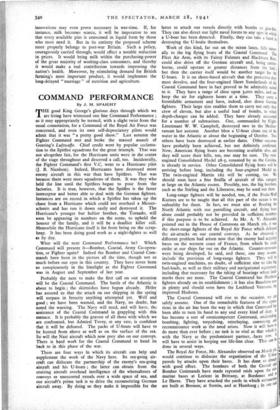THE PRICE OF MILK
By P. LAMARTINE YATES
ILK in Britain is indeed a pearl of great price. Nowhere else in the world do doctors and nutrition-experts so rsistently emphasise the value of milk in building up health, owbere else do they so loudly praise its virtues as an almost *ere food containing protein, fats, vitamins and mineral alts, nowhere else has the public been so often urged to drink more milk "; yet nowhere else in the world does it st so much to buy.
The high price of British milk is no mere war-time pheno- non. For instance, in the period 1936-38 when milk sold call at 2s. 4d. per gallon in England, it fetched the equivalent rod. in Belgium, is. Id. in Germany, is. 2d. in Denmark, e dearest on the Continent being Swiss milk at is. 4d. Small onder that most Continental people drink more milk than e do. But how is such a startling price-difference possible?
erein lies the secret of Continental cheapness? Broadly peaking, the honours are shared between producers and dis- ibutors. Western European producers were getting at that :e about 8d. per gallon for their milk (the Danes only got . compared with the British producer's price of is. 3c1. n the Continent the average distribution-costs ranged from I. to 8d., compared with I id. to Is. per gallon in Britain.
is perfectly true, of course, that across the Channel dis- ibutors' services are, on the whole, less elaborate, and when ev do equal our own they often cost quite as much to form. In Amsterdam in 1938 the distributors' margin on tiled milk was is. 2d., but in country districts it was 4d.
o id. The same was true of Denmark. Yet that in itself is gnificant. In England, unfortunately, we have as a flat-rate rgin all over the country (or nearly), one which covers stribution-costs in the biggest cities. In most country-areas 1k could probably be sold with profit at about half the ndon retail price, yet to try to do that would be an offence.
To some extent these high prices date back to the last war; ut the situation has worsened in the last seven years, the perations of the Milk Marketing Boards having coincided ith all-round price increases both to producers and distri- utors. Consequently we, as a nation, have become accustomed o expensive milk, and fail to realise how seriously high prices restricting consumption. It is like asking people to pay ore than they can afford for main drainage, and then being urprised when, for lack of it, they fall a prey to disease.
In regard to milk nothing could be more dangerous than mplacency. If we come to look upon the current (or even 1938) level of prices as " inevitable," then we are drnitting that milk must remain right outside the reach of ose vast sections of the community who. most need it for ealth. For in that case the gap between the cost of milk d what the masses can afford to pay remains so large that o reasonable subsidies could bridge it. If, on the other hand, e keep an open mind about price, if we are prepared to xplore all manner of ways and means of effecting reductions, n the problem of bringing milk to those who need it may of appear so insoluble. With this objective in view, let us amine briefly the reasons why milk is so much cheaper on e Continent.
The first obvious difference is wages. Even at their pre-war verage of 35s. per week British farm-labourers earned sub- tantially more than their opposite numbers in continental urope: the Belgians, for instance, only earned 20S. Further- Ore, British smallholders and family-farmers obtained better Comes, despite all their grumbling, than Continental peasants. s is a fact too little mentioned, yet it is a thing to be proud In this, at least, we have no wish to imitate our neighbours. erertheless, labour is not the biggest item in the costs of k-production. The feeding-stuffs bill is much more Nrtant, and here possibly British farmers may find some- g to learn. Before this war the cost of feeding-stuffs to the ry farmer averaged about 6d. per gallon of milk produced, sum which in Denmark would swallow up the entire milk receipts. Danish farmers only spent about 4d. on feeds. Here, then, is one significant fact. Of course, it was not merely that the feeds cost less per ton—though the home-grown certainly did, because Danish yields per acre are higher than ours—it was also that the Danish producers obtained more gallons of milk for every ton of fodder fed to the cows. The cows were more efficient converters. Average milk-yield in Denmark in 1936-38 was over 700 gallons per cow as against just over 500 in Britain. The Danes keep fewer low-yielding cows eating their heads off at their owners' expense.
Another significant difference is that the Danes, and for that matter the Dutch, too, sell all their milk at one price: milk for the liquid market fetches 6d. just like the milk for butter- making. Here, in Britain, the markets came to be artificially separated, so that farmers could sell for liquid consumption at is. 31d. while they only got 6d. to 7d. for manufacturing milk, this giving them a " pool price" of about is. They thus, at the expense of the liquid consumer, made up for their losses on milk used for butter and cheese. Such a policy, however, is probably not in the public interest. It might well be preferable, from the point of view of the nation's health, to sell all, or nearly all, the milk in the liquid market. Assuming, for instance, that producers need to average Is. per gallon over the year as a whole, it might be better, and equally in the producers' interest, to reduce prices from is. 3d. in the winter to, say, rod. in the summer months, so as to dispose of the entire summer-surplus to liquid-consumers. The pro- ducers believe that this cannot be done; they assert that demand will not respond vigorously enough to a seasonal price- reduction of only id. per pint. But if at the same time economies could be effected in distribution, the reduction might be made more substantial. It might even be wise to charge less for distribution in summer than in winter.
This brings us to the vexed question of distributors' costs. Here there are two distinct problems. First, there is the waste- fulness and over-elaboration of delivery services, about which so much has been written: eight roundsmen up each street, too many deliveries per day, the expensiveness of bottles— especially half-pint bottles. Because retail prices are fixed the pressure of competition is not allowed to operate so as to reduce prices and eliminate the inefficient. Nor is public control used to improve organisation and eliminate waste. Con- sumers get the worst of both worlds.
The second problem is that of different margins in different districts. It may have cost rod. per gallon (in 1938) to pasteurise, bottle and distribute milk in the London area, but it only cost 7d. in Derby; and in rural districts, particularly if people were willing to forgo pasteurising and bottling, it would cost still less. Yet the fixed margin varies hardly at all as between large and small towns, and even producer- retailers who sell milk in the jug from their own doorsteps have to observe the legal retail price. Nowhere on the Continent does such a system exist. Indeed, the low average distribution margins abroad are mainly achieved by allowing those concerned to charge less for delivery in rural areas where services are simplified.
From this brief analysis what general conclusions can be drawn? In what directions may we hope to reduce the price of British milk, and so stimulate a greater liquid consumption? What should be our policy when it comes to post-war recon- struction? Firstly, at the production end, the hopeful lines of advance seem to be in the direction of more careful breeding of dairy-cattle (based on milk-recording) and more economical methods of feeding. Secondly, producers' price policy should be reorientated with a view to disposing of practically the entire milk-supply in the liquid market. Thirdly, the retail price should be de-controlled, so that high margins need only be allowed in areas where distribution costs are really high. Fourthly, experiments should be made in particular areas in concentrating distribution under a single organisation so as to eliminate overlapping and waste. Some of these innovations may even prove necessary in war-time. If, for instance, milk becomes scarce, it will be imperative to see that every available pint is consumed in liquid form by those who most need it. But in its entirety the proposed scheme more properly belongs to post-war Britain. Such a policy, courageously carried through, would effect a notable reduction in prices. It would bring milk within the purchasing-power of the great majority of working-class consumers, and thereby it would make a real contribution towards improving the nation's health. Moreover, by stimulating demand for British farming's most important product, it would implement the long-delayed " marriage " of nutrition and agriculture.































 Previous page
Previous page